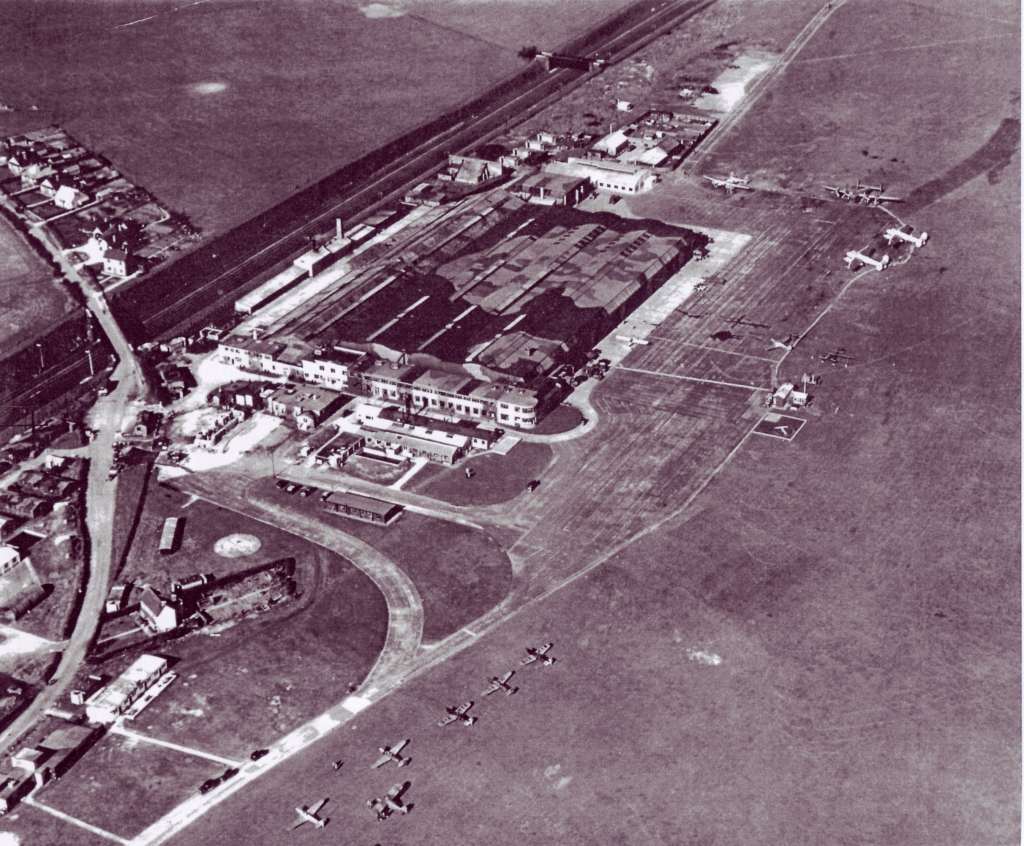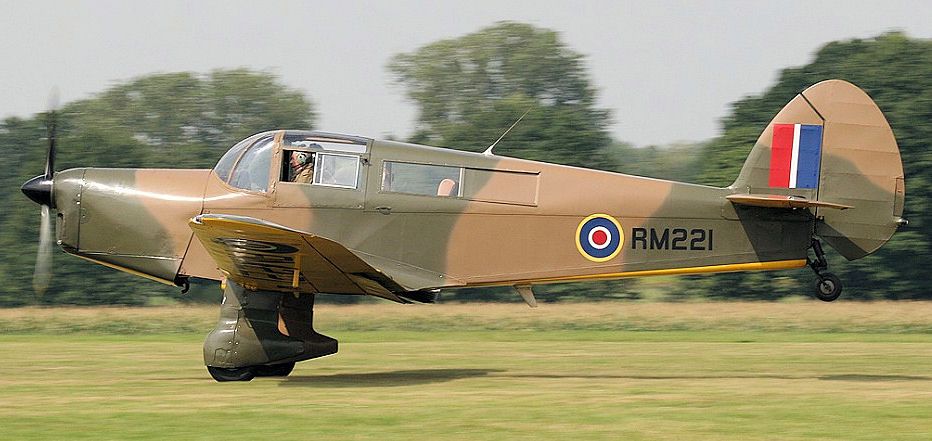
(5ft-2ins) Margaret (Cunnison) Ebbage (29th May 1914 – 4th January 2004) was a Scottish Aviatrix and the 1st Scottish Woman Flying Instructor. She was one of the ‘First 8‘ Women to join the Air Transport Auxiliary.
Margaret was born in Haddington in 1914. Her Family was originally from Blairgowrie, in Perthshire, but they were living at 19 Montrose Gardens Milngavie. Her father, James Cunnison was a Lecturer in Political Economy at the University of Glasgow. Margaret went to Laurel Bank School.
In 1933 Cunnison entered a Competition to win an “Air Scholarship” with the Evening News. She won Lessons with the Scottish Flying Club. She got her A-Licence in Scotland then travelled to Lympne, Kent, to get her B-Licence & gained the 2nd Scottish Woman’s Commercial Pilot’s Licence. Margaret was engaged by the Scottish Flying Club in their Workshop at Renfrew Aerodrome & partly to enhance awareness of & interest in Flying, she was Employed to take Holidaymakers on Joy-rides at Ettrick Bay. Another Assignment of which she had vivid memories was a Flight to Stornoway, Lewis with the 1937 Coronation Newspapers the Day after the Event. She was already an Instructor having worked with the Strathtay Aero Club based at Newlands Aerodrome, Perth. This Job lasted until the early days of WW2.


Cunnison joined the Air Transport Auxiliary (ATA) with the other Initial 8-Women in 1940. Together they were known as the First Eight & Appointed by the Commandant of the ATA‘s Women’s Section, Pauline Gower. Cunnison was the Leading Instructor Initially at the Hatfield Aerodrome Base responsible for Evaluating & Training the New Pilots. After couple of years at Hatfield, she was posted to Luton as an instructor; her report at the time said she “is a steady and reliable pilot. She works extremely Hard & has proved invaluable as an Instructor on Light Types”. She Signed off on the American Women Pilots at the Later No.5 Ferry Pool Luton (Barton-in-the-Clay, 6-miles North of Luton, Beds). Barton-in-the-Clay Aerodrome was 1st Established in 1935 to the West of the Village, on Farmland owned by the nearby Brook End Green Farm, where she was responsible for Appraising & Training New Recruits.
She was subsequently Posted to White Waltham, in Berks. As a result of her Role, Cunnison mostly Flew Light Aircraft. She did, indeed, only work on ‘light types’; her log book shows ‘Moth, Magister, Courier, Master, Oxford, Hart, Proctor, Rapide, Anson & Piper Cub‘. She was promoted to Flight Captain in Feb 1942, but suffered a bout of appendicitis from July to October & then went off sick again on the 19th December 1942 & never returned to the ATA; her Contract was terminated in March 1943.


Some 25-American Women came to Fly for the ATA in 1943, as over 24 of their Brothers did in previous years.
The 1st US Female was Jackie Cochran was part of “Wings for Britain“, an Organisation that Ferried American Built Aircraft to Britain, becoming the 1st Woman to Fly a US Bomber (a Lockheed Hudson V) across the Atlantic. General Hap Arnold knew that women were being used successfully for ATA in England so Arnold suggested that Cochran take a Group of Qualified Female Pilots to see how the British were doing. He promised her that no decisions regarding Women Flying for USAAF would be made until she returned. In Britain, she Volunteered her Services to the RAF. For several months she worked for the British ATA, Recruiting qualified Women Pilots in the United States & taking them to England to Join the ATA. Cochran attained the Rank of Flight Captain (equivalent to a Squadron Leader in the RAF or a Major in the USAAF) in the ATA.
On 22nd July 1940 No.24 Elementary Flying Training School (EFTS) was established at Luton & Barton-in-the-Clay was assigned as a Relief Training Ground as the Main Luton Airfield became more congested. When the EFTS relocated, Luton Airfield became the Home of No.5 Ferry Pool, ATA, who also used ‘Barton-in the Mud’ as its Relief Training Ground. No.5 Ferry Pool had relocated from the Hatfield de Havilland Aircraft Company Factory Site & later moved operations to Haddenham, Bucks (RAF Thame), in 1943 though they retained use of the Barton Airodrome, transporting Student Pilots by Bus each day until the ATA disbanded at the end of November 1945. Barton Airfield returned to Civil use post-1945, with the Grass Airstrip being returned to Agriculture & the Buildings being occupied for Industrial use. The Airfield has an active Research Group which documents its findings on the now Barton-Le-Clay Community Website. In 1939 the newly Established Marendaz Aircraft Ltd built a 2-Seat, single-Engined Low wing cantilever Monoplane called the Marendaz Trainer at the Aerodrome. Donald Marendaz, the Company’s Founder, claimed to have Designed it though this has been disputed, not least because Marendaz had claimed the Work of others as his own before. If it was not his, the true Designer is unknown. The Sole Trainer, registered G-AFZX 1st flew in November 1939 with R A Wyndham at the Controls. It seems to have flown well, though it is not known if the Front Seat was ever occupied or Ballasted. By this time the UK was at War, so the Aircraft went to the RAF Halton Squadron of the Air Training Corps in 1940 and was later scrapped after a Crash.

With the Death in December 2020 of Eleanor Wadsworth at the age of 103, there remain only 2-surviving Female ATA Pilots, American Nancy Stratford (co-Author of Contact! Britain!: A Woman Ferry Pilot’s Story during WW2) and Jaye Edwards, who now lives in Canada. Wadsworth had joined the ATA in 1943 and went on to Fly a total of 22-different Aircraft Types and Flew Spitfires on 132 occasions.
Overall during WW2 there were 166-Women Pilots, 1 in 8 of all ATA Pilots, and they Volunteered from Britain, Canada, Australia, New Zealand, South Africa, the United States, the Netherlands & Poland. From Argentina & Chile came Maureen Dunlop & Margot Duhalde. Fifteen of these Women Lost their lives in the Air, including the British Pioneer Aviatrix Amy Johnson & Joy Davison. Two of the Women Pilots received Commendations; one was Helen Kerly.

Cunnison took Leave of ATA to get Married in 1941 to Geoffrey Ebbage, an Ophthalmic Surgeon with the RAMC, whom she had met when they were both Stationed in Hatfield. After the War they settled in London, where their son was born in 1948. Margaret lived most of the rest of her life there until she moved to Haddington in 1994 to be near her extended Family. She died on 4th January 2004 aged 89


At the time my Home was in Bristol so I was happy to take the opportunity of a Ride in an Argus that was going to an Airfield just outside Bath. The Pilot was an attractive Cadet who was reputed to be a Pacific island Princess. I declined her offer for me to take the Controls & said I would Map Read. Reaching our destination we found Jets were using the Out of Wind Runway. It was quite Windy & I suggested we should use the Runway that was into the Wind. However she ignored my Advice & give her due, made a Text Book Touchdown which was subsequently marred by a Gust of Wind catching the underside of the Port Wing and Tipping the Plane on its side. The result was I found myself half out of the Aircraft with her on Top. No injuries but it would have been quicker to have gone by Train in view of the time spent on Report Writing. Although I did not sign the Form-700 which would have made me Captain of the Aircraft nevertheless as usual I got the Blame.

ATA Pilots could be expected to Ferry any Type of Plane that came within their Classification & that could amount to Dozens. Accordingly we were Issued with a thick Note Book containing Essential details of every RAF Aircraft. This allowed Pilots to check what to do before Take off and while in the Circuit Preparatory to Landing. Having been given a Fairey Barracuda to Ferry from Wroughton to Kirkbride & confronted with this somewhat weird looking Aircraft I discovered the one thing the Book did not mention was how to get into it. For this I had to ask the Ground Crew.

On one memorable occasion I had a Spitfire IX, a more powerful Model than the Spitfire V that I cut my Teeth on. This was to be taken from Cowley to RAF Cosford (Shrops). The Airfield at Cowley was surrounded by Buildings which gave the impression of it being smaller than it was. The Plane had been on Dispersal for sometime because when I took off my forward vision was completely cut off by a Cascade of Water coming from the Nose. Safely Airborne I decided to follow the Railway Line to Bristol & follow the Severn Valley to Cosford. Just as well because no sooner had I started than the Constant Speed Unit on the Propeller started to Leak making forward Vision impossible. As a precaution I Throttled back but even so the Speed was still 120-mph. I eventually Landed at RAF Colerne (Wilts) for Repairs, which happens to be near Bristol. – W H Aldrich
